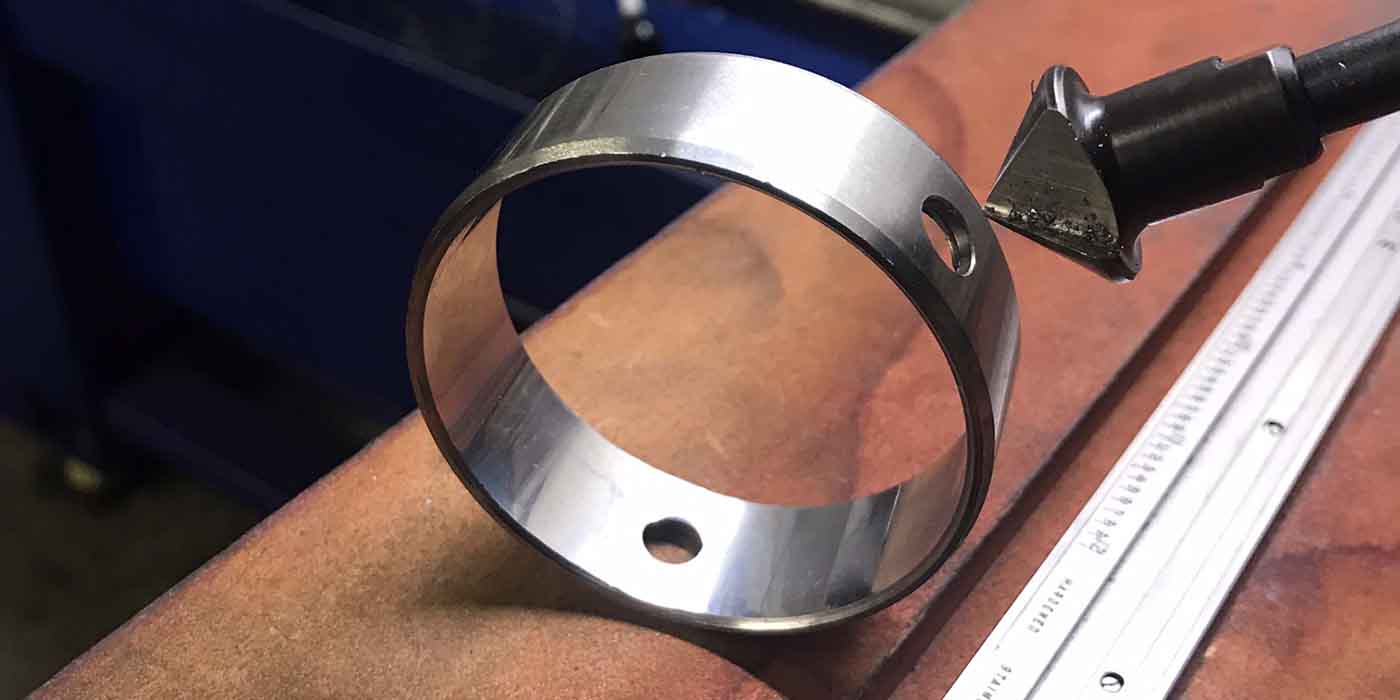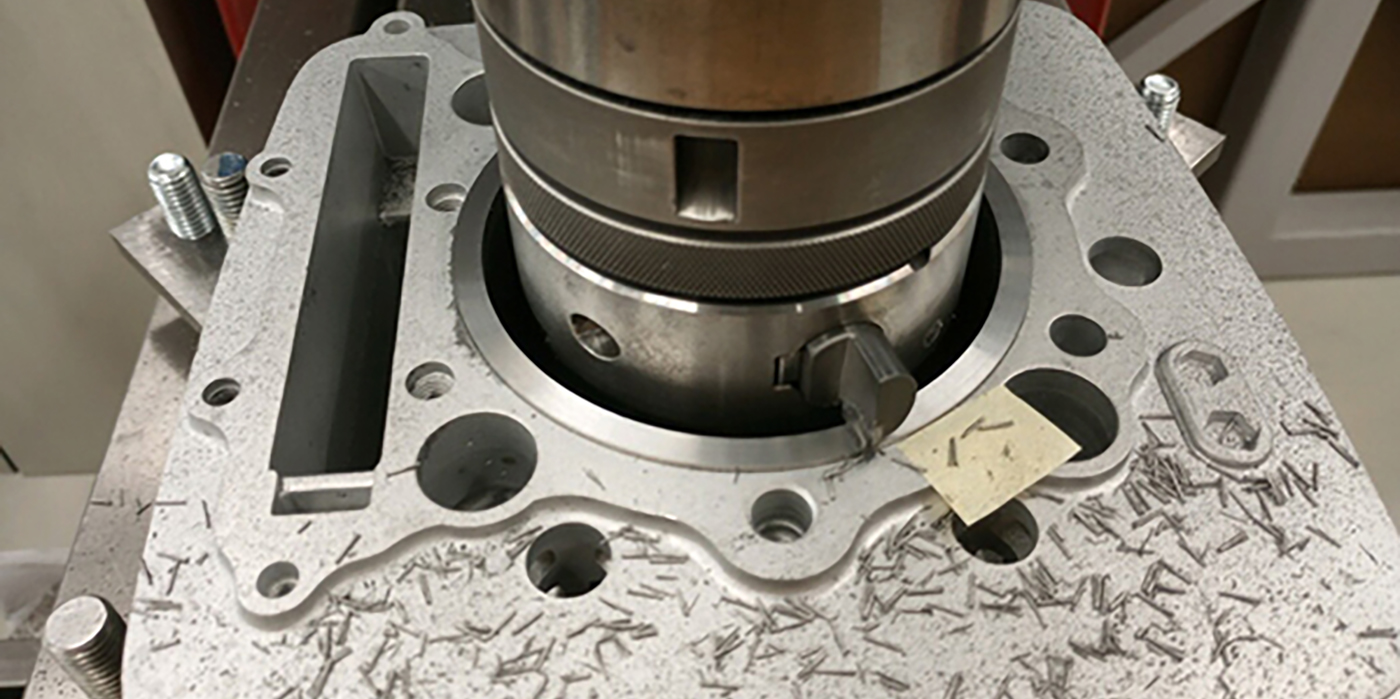CAST IRON THREAD PLUGS
I make my own large threaded repair bushing from tapered pipe thread oil galley plugs, with an internal hex. The material of these plugs is hard enough to tap clean threads into, and very similar to your cast iron block or head. They are available in many sizes and the internal hex works well as a drill guide with a perfect center. These work well for jobs like stripped Chevy starter bolt holes, that someone else failed to repair. On these, I have made a drill guide that bolts to the block existing holes and allows me to drill the hole out large enough to find the original center.
Keith Hennen
Hennen Engine Parts & Machine
Green Isle, MN
IN-SHOP CAMSHAFT ANALYSIS
Our shop has had a cam analyzer for over 28 years, so I had forgotten how we checked and identified cams in the past. Recently, I was asked by another shop how to verify which of three customer-supplied cams to install in the customer’s engine. The previous shop that had built his engines had ground the name and ID numbers off of all three camshafts!
I told him to install the cam in his lathe on centers, with a degree wheel on the tailstock end and to put a pointer on the degree wheel as well. A small piece of heater hose over the tailstock center will hold the degree wheel up against the end of the cam.
I then instructed him to put a magnetic base dial indicator on the lathe’s cross slide and set it up against a lobe. We zeroed the pointer, then the dial indicator and rotated the cam until the indicator read .050”. At that time we set the degree wheel to zero without moving the cam. We then rotated the cam over the lobe until the indicator again read .050” and read the number. When multiplied by two, this number is the duration at .050 for that lobe.
Do each lobe a few times until you get repeatable results, then move on to that cylinder’s other lobe and do the same thing. Then move to the lobe’s top and zero the indicator. Go .050” down one side of the lobe and zero the degree wheel, then go up over the top of the lobe to .050” down the other side of the same lobe. Read the degree difference, divide by two and set the degree wheel to zero. Move the indicator to that cylinder’s other lobe, and zero the indicator again at the lobes top. Go down one side .050” and record the number, then go down the other side of the lobe .050” and record that number. Again divide by two, subtract the one number from the other number again, and that is your lobe center in degrees.
Play with a known cam until you get the hang of things and can get good results. You may be off a few degrees one way or another, but with care you will get close enough to identify an unknown cam.
The lobe lift is easily found. For that number just zero the indicator on the base circle, then rotate the cam to the highest number, and that will be the lobe lift. Multiply that by the rocker ratio and you have the lift at the valve.
Any shop that grinds the numbers off of a cam to keep the customer coming back to his shop may be in for a surprise. Nearly every time we ID an unknown cam for a new customer, he becomes OUR customer. We do the ID cheaply enough to show people that there is more than one way to run a business.
Timm Jurinc
Tuf-Enuf Auto & Marine Performance
Avondale, AZ
REDUCE – HEAT, PRESSURE, STRESS
In the machine shop business we often consider stress, heat and pressure, as it relates to combustion, compression, bi-metals, etc. But when the weather gets extremely hot, like it’s been this summer, it’s also important for managers to consider the heat, pressure, and stress on our employees.
There are four environmental factors which affect the amount of stress a worker faces in a hot work area: temperature, humidity, radiant heat (such as from a Hot Tank) and air velocity. OSHA makes lots of common sense recommendations for business managers, like shielding workers from radiant heat sources, use of fans and cooling units, etc. However, for most small businesses, education is the most important factor so workers are aware of the need to replace fluids and salt lost through sweat.
Supervisors should consider an individual worker’s physical condition when determining fitness for hot environments. Alternating work and providing longer rest periods in cool areas can help workers avoid heat stress. Many shops alter their business hours by starting early in the morning so they can put in a full day’s work and close shop before temps reach their daily peak.
Steve Rich
Sterling Bearing, Inc.
N. Kansas City, MO
DOING THE LS CRANK STAND
Since the new LS motors all have reluctor rings, my son and I figured out a relatively easy way to stabilize our cranks when we are installing the reluctor ring to the crank. We honed out a junk harmonic balancer to use as a stand for reluctor ring installation. It keeps the crank stable while we are working with the heated reluctor ring. We also use other junk harmonic balancers to fit our other pressed cranks. It keeps the crank stable and allows us to complete the task without trying to balance the crank on its own.
Carl Boyd, Jr
The Engine Shop
Collingdale, PA














